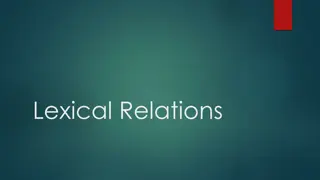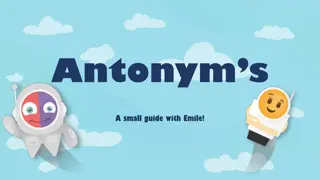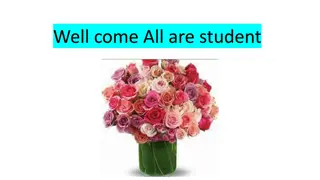Understanding Antonyms: Types and Examples
Antonyms are words with opposite meanings, such as alive/dead, big/small, and happy/sad. They are categorized into gradable and non-gradable types, each serving distinct linguistic functions. While gradable antonyms can be used comparatively, non-gradable antonyms do not allow for such comparisons. The negative test is employed to identify non-gradable antonyms, avoiding the description of one member of an antonymous pair as the negative of the other.
Download Presentation

Please find below an Image/Link to download the presentation.
The content on the website is provided AS IS for your information and personal use only. It may not be sold, licensed, or shared on other websites without obtaining consent from the author. Download presentation by click this link. If you encounter any issues during the download, it is possible that the publisher has removed the file from their server.
E N D
Presentation Transcript
Sense and Antonyms Two forms with opposite meanings are called antonyms. Some common examples are the pairs: alive / dead, big / small, fat / slow, happy / sad, hot / cold, rich / poor, true / false long / short, male / female, married / single, old / new,
Sense and Antonymy Antonyms are usually divided into two main types: Gradable opposites along a scale Non-gradable direct opposites
Gradable antonyms Gradable antonyms, such as big / small, It can be used in comparative constructions like I m bigger than you A pony is smaller than a horse.
Gradable antonyms The negative of one member of a gradable pair does not necessarily implicate the other. For example, the sentence My car isn t old does not necessarily mean My car is new.
Non-Gradable antonyms With complementary pairs ) , comparative constructions are not normally used. We DON T typically describe someone as deader or more dead than another. (also called non-gradable antonyms
Non-Gradable antonyms With complementary pairs ) , comparative constructions are not normally used. The negative of one member of a non-gradable pair does imply the other member. That is, My grandparents aren t alive does indeed mean My grandparents are dead (also called non-gradable antonyms
Negative Test Although we can use the negative test to identify non-gradable antonyms in a language, we usually avoid describing one member of an antonymous pair as the negative of the other.
Negative Test For example, while undress can be treated as the opposite of dress, it does not mean not dress . It actually means do the reverse of dress . Antonyms of this type are called REVERSIVES
REVERSIVES Other common examples of REVERSIVES are: enter / exit, pack / unpack, lengthen / shorten, raise / lower, tie / untie
Hyponymy When the meaning of one form is included in the meaning of another, the relationship is described as HYPONYMY. Examples are the pairs: animal / dog, dog / poodle, vegetable / carrot, flower / rose, tree / banyan. Vehicle/ car
Hyponymy The concept of inclusion involved in this relationship is the idea that if an object is a rose, then it is necessarily a flower, so the meaning of flower is included in the meaning of rose. Rose is a hyponym of flower.
Hyponymy When we consider hyponymous connections, we are essentially looking at the meaning of words in some type of hierarchical relationship. We can represent the relationships between a set of words as a hierarchical diagram.
Hyponymy The concept of a prototype helps explain the meaning of certain words like bird, not in terms of component features (e.g. has feathers , has wings ), but in terms of resemblance to the clearest example.
Hyponymy- Prototype While words like canary, cormorant, dove, duck, flamingo, parrot, pelican and robin are all equally co- hyponyms of the super-ordinate bird, they are not all considered to be equally good examples of the category bird . Shows Robin shows the most characteristic instance of the category bird is robin
Hyponymy- Prototype Thus, even native speakers of English might wonder if ostrich or penguin should be hyponyms of bird (technically they are), but have no trouble deciding about sparrow or pigeon. These last two are much closer to the prototype.
Homonyms When two or more different (written) forms have the same pronunciation, they are described as homophones. Common examples are bare / bear, meat / meet, flour / flower, pail / pale, right / write, sew / so and to / too / two.
Homonyms We use the term homonyms when one form (written or spoken) has two or more unrelated meanings, as in these examples: bank ( of a river) bank (financial institution) Bat (flying creature) bat (used in sports) mole (on skin) mole (small animal) pupil (at school) pupil (in the eye) race (contest of speed) race (ethnic group)
Homonyms bank ( of a river) bank (financial institution) The temptation is to think that the two types of bank must be related in meaning. They are not. Homonyms are words that have separate histories and meanings, but have accidentally come to have exactly the same form.
Polysemy When we encounter two or more words with the same form and related meanings, we have what is technically known as polysemy. Polysemy can be defined as one form (written or spoken) having multiple meanings that are all related by extension.
Polysemy Examples are the word HEAD, used to refer to the object on top of your body, on top of a glass, person at the top of a company or department and many other things.
Polysemy run Running person, Running water, Running nose Running a business Running machine Running colours.
Polysemy If the word has multiple meanings (i.e. it is polysemous), then there will be a single entry, with a numbered list of the different meanings of the word. If the two words are treated as homonyms, they will typically have two separate entries.
Polysemy It is possible for two forms to be distinguished via homonymy and for one of the forms also to have uses via polysemy. date (= a thing we eat) and date (= a point in time) They are homonyms.
Polysemy Date = a point in time is polysemous in terms of a particular day and month (= on a letter), an arranged meeting time (= an appointment), a social meeting (= with someone we like), and a person (= that person we like). She is my blind date
Metonymy A type of relationship based on a close connection in everyday experience, which can be based on: container-contents relation (bottle / water, can / juice) whole-part relation (car / wheels, house / roof) r representative-symbol relationship (king / crown, the President /White House)
Metonymy Using one of these words to refer to the other is an example of metonymy. It is our familiarity with metonymy that makes it possible for us to understand He drank the whole bottle although it sounds absurd literally (i.e. he drank the liquid, not the glass object).
Metonymy We also accept without being puzzled that buildings appear to be talking when we hear: The White House has announced or Downing Street protested
Metonymy Many examples of metonymy are highly conventionalized and easy to interpret. However, other examples depend on an ability to infer what the speaker has in mind. Get your butt over here. The strings are too quiet. I prefer cable.
Metonymy Get your butt over here. The strings are too quiet. I prefer cable. Making sense of such expressions often depends on context, background knowledge and inference.
collocation We know that some words tend to occur with other words. If you ask a thousand people what they think of when you say hammer, more than half will say nail. Hammer NAIL
collocation If you say table, they will mostly say chair, butter elicits bread, needle elicits thread salt elicits pepper.
collocation One way we seem to organize our knowledge of words is simply on the basis of collocation, or frequently occurring together. This is determined by usage (frequency of occurrence) where the two co-occur frequently in texts, or discourses
The Ultimate Question How can we apply our understanding of semantic features, semantic roles and lexical relations in discourse (Text) analysis?























